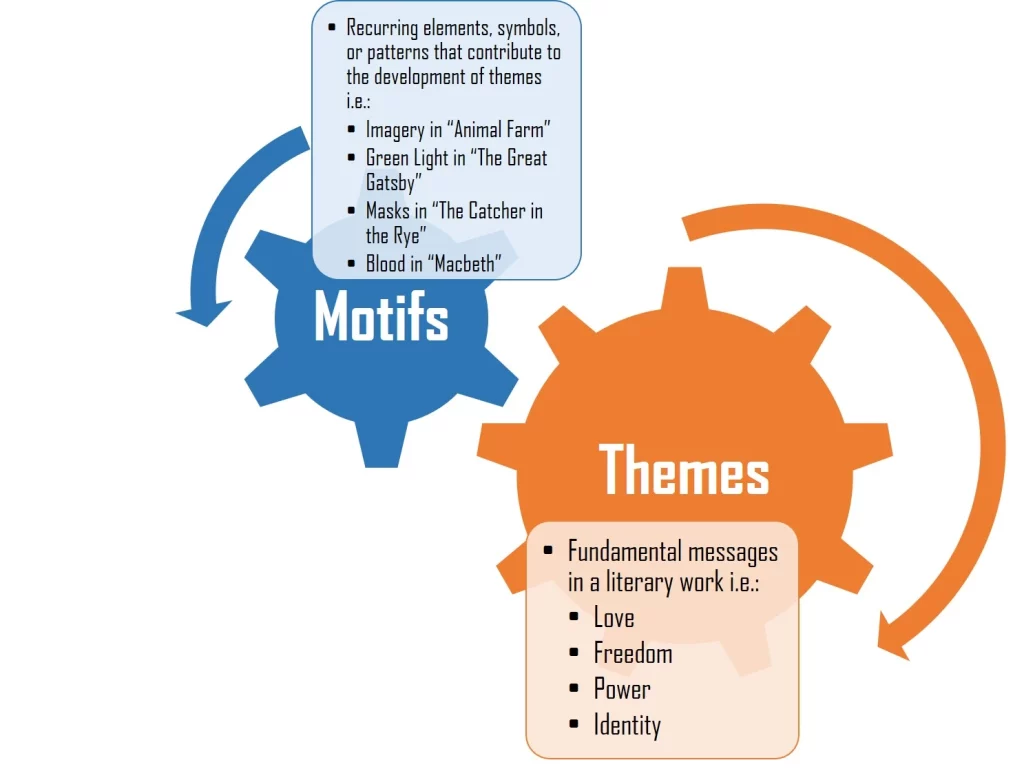
Theme and motif analysis involves examining recurring ideas, concepts, symbols, or patterns within a literary work or across multiple works by the same author or within a specific genre or time period. Themes are overarching ideas or messages that convey deeper meanings, while motifs are recurring elements or symbols that contribute to the development of those themes. Here’s a breakdown of themes and motifs analysis:
Themes vs. Motifs
Themes:
Themes are the fundamental and universal ideas or messages explored in a literary work. They often address broader concepts, such as love, death, freedom, power, or identity, and they provide insight into the author’s perspective on these topics. In a themes analysis, you:
- Identify Themes: Recognize the central ideas or concepts that are repeated or explored throughout the work(s).
- Analyze Themes: Examine how these themes are developed, how they relate to the plot and characters, and what insights they offer about the human condition or society.
- Provide Evidence: Support your analysis with specific examples, quotes, or scenes from the text(s) that illustrate the themes.
- Consider Variations: Explore how themes may evolve or shift within the work(s) and how different characters or storylines may relate to different aspects of the same theme.
Motifs:
Motifs are recurring elements, symbols, or patterns that contribute to the development of themes in a literary work. They are often smaller in scope than themes but play a significant role in reinforcing or elaborating on those themes. In a motifs analysis, you:
- Identify Motifs: Recognize the recurring elements, symbols, or patterns that appear throughout the work(s).
- Analyze Motifs: Examine the significance of these recurring elements in relation to the themes. How do they enhance the reader’s understanding of the themes?
- Explore Variations: Consider how the motifs may change or evolve over the course of the narrative or how different characters may be associated with specific motifs.
- Highlight Connections: Explain how motifs are interrelated and how they contribute to the overall meaning and impact of the work(s).
For example, in F. Scott Fitzgerald’s “The Great Gatsby,” a central theme is the American Dream, and motifs such as the green light, the eyes of Doctor T.J. Eckleburg, and parties at Gatsby’s mansion reinforce this theme by symbolizing aspects of wealth, illusion, and moral decay.
In summary, themes and motifs analysis involves examining the fundamental ideas and recurring elements in a literary work to gain a deeper understanding of the author’s intended messages and the thematic resonance of the narrative. It helps readers uncover layers of meaning and symbolism within the text.
Essential Themes & Motifs Analysis Writing Tips
- Identify and Define Themes and Motifs:
- Provide Context:
- Analyze How Themes are Developed:
- Explore Motif Variations:
- Consider Motif Connections:
- Provide Evidence:
- Analyze Authorial Intentions:
- Relate to Characters and Plot:
- Consider Multiple Works (if applicable):
- Reflect on Reader Impact:
By following these “Do” and “Don’t” guidelines, you can conduct a thorough and insightful theme and motif analysis that illuminates the deeper layers of meaning and symbolism within the text(s).
Examples
- Theme: Corruption of Power and Motif: Animal Imagery in “Animal Farm” by George Orwell:
- Theme: The American Dream and Motif: The Green Light in “The Great Gatsby” by F. Scott Fitzgerald:
- Theme: Loss of Innocence and Motif: Mockingbird in “To Kill a Mockingbird” by Harper Lee:
- Theme: The Struggle for Identity and Motif: Masks in “The Catcher in the Rye” by J.D. Salinger:
- Theme: The Duality of Human Nature and Motif: Light and Darkness in “Dr. Jekyll and Mr. Hyde” by Robert Louis Stevenson:
- Theme: The Consequences of Ambition and Motif: Blood in “Macbeth” by William Shakespeare:
- Theme: The Nature of Humanity and Motif: Eyes in “The Great Gatsby” by F. Scott Fitzgerald:
- Theme: The Struggle for Freedom and Motif: Birds in “The Awakening” by Kate Chopin:
- Theme: The Alienation of Modern Life and Motif: The Absurd in “The Stranger” by Albert Camus:
- Theme: The Search for Identity and Motif: Water in “Song of Solomon” by Toni Morrison:
- Theme: The Impact of War and Motif: Darkness in “Heart of Darkness” by Joseph Conrad:
- Theme: The Struggle for Survival and Motif: Fire in “The Road” by Cormac McCarthy:
- Theme: The Loss of Innocence and Motif: Fairy Tales in “The Bloody Chamber” by Angela Carter:
- Theme: The Power of Storytelling and Motif: Stories Within Stories in “One Thousand and One Nights” (Arabian Nights):
- Theme: The Dehumanizing Effects of Totalitarianism and Motif: Surveillance in “1984” by George Orwell:
- Theme: The Struggle for Social Justice and Motif: The Mockingbird in “To Kill a Mockingbird” by Harper Lee:
- Theme: The Nature of Heroism and Motif: The Quest in “The Lord of the Rings” by J.R.R. Tolkien:
- Theme: The Search for Meaning and Motif: Existentialism in “The Stranger” by Albert Camus:
- Theme: The Complexity of Human Emotions and Motif: Weather in “Wuthering Heights” by Emily Brontë:
- Theme: The Loss of Innocence and Motif: Masks in “Lord of the Flies” by William Golding:
- Theme: The Complexity of Family Relationships and Motif: The Tree in “The Poisonwood Bible” by Barbara Kingsolver:
- Theme: The Search for Identity and Motif: Mirrors in “The Picture of Dorian Gray” by Oscar Wilde:
- Theme: The Complexity of Memory and Motif: Time in “One Hundred Years of Solitude” by Gabriel García Márquez:
- Theme: The Power of Love and Motif: The Red Rose in “The Scarlet Letter” by Nathaniel Hawthorne:
- Theme: The Nature of Good vs. Evil and Motif: The Conch Shell in “Lord of the Flies” by William Golding:
These examples illustrate how themes and motifs can enhance the depth and complexity of literary works, providing readers with deeper insights into the author’s intended messages and the thematic resonance of the narratives.
